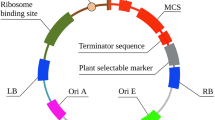Abstract
Transglutaminases have a range of catalytic activities, most of which concern the post-translational modification of proteins. The most important of these activities is the cross-linking of proteins into large supramolecular networks. The widespread use of transglutaminases has increased the demand for an inexpensive, efficient and safe source of recombinant enzyme. We explored the use of plant-based systems for the production of this important industrial enzyme. Transgenic rice plants engineered with a rat prostate transglutaminase (rTG p ), driven by the strong constitutive maize-1 ubiquitin promoter and its first intron, were shown to express the recombinant enzyme at the mRNA and protein levels. The Ca2+ dependence of the recombinant enzyme was confirmed by the biotin-labelled cadaverine-incorporation assay. In this communication we report the molecular and biochemical characterisation of transgenic plants expressing rTG p and this sets the stage for establishing a bioreactor system for the production of transglutaminases in plants.
Similar content being viewed by others
References
Bassie L, Noury M, Lepri O, Lahaye T, Christou P and Capell T (2000) Promoter strength influences polyamine metabolism and morphogenic capacity in transgenic rice tissues expressing the oat arginine decarboxylase cDNA constitutively. Transgenic Res 9: 33–42.
Burgoyne RD and Weiss JL (2001) The neuronal calcium sensor family of Ca2+-binding proteins. Biochem J 353: 1–12.
Christensen AH and Quail PH (1996) Ubiquitin promoter-based vectors for high-level expression of selectable and/or screenable marker genes in monocotyledonous plants. Transgenic Res 5: 213–218.
Collighan R, Cortez J and Griffin M (2002) The biotechnological applications of transglutaminases. Minerva Biotech 14: 143–148.
Edwards K, Johnstone C and Thompson C (1991) A simple and rapid method for the preparation of plant genomic DNA for PCR. Nucl Acids Res 19: 1349.
Griffin M, Casadio R and Bergamini CM (2002) Transglutaminases: nature's biological glues. Biochem J 368: 377–396.
Ho KCh, Quarmby VE, French FS and Wilson EM (1992) Molecular cloning of rat prostate transglutaminase complementary DNA. The major androgen-regulated protein DP1 of rat dorsal prostate and coagulating gland. J Biol Chem 267: 12660–12667.
Lilley G, Skill J, Griffin M and Bonner P (1998) Detection of Ca2+-dependent transglutaminase activity in root and leaf tissue of monocotyledonous and dicotyledonous plants. Plant Physiol 117: 115–1123.
Lorand L and Graham RM (2003) Transglutaminases: crosslinking enzymes with pleiotropic functions. Nature Rew 4: 140–156.
Sambrook J, Fritsch EF and Maniatis T (1989) Molecular Cloning: A Laboratory Manual. 2nd edn. Cold Spring Harbor Press, New York.
Serafini-Fracassini D, Del Duca S and D'Orazi D (1988) First evidence for polyamine conjugation mediated by an enzymic activity in plants. Plant Physiol 87: 757–761.
Stöger E, Sack M, Fisher R and Christou P (2002) Plantibodies: applications, advantages and bottlenecks. Curr Opin Biotech 13: 161–166.
Sudhakar D, Duc LT, Bong BB, Tinjuangjun P, Maqbool SB, Valdez M et al. (1998) An efficient rice transformation system utilizing mature seed-derived explants and a portable, inexpensive particle bombardment device. Transgenic Res 7: 289–294.
Trung-Nghia P, Bassie L, Safwat G, Thu-Hang P, Lepri O, Rocha P et al. (2003) Reduction in the endogenous arginine decarboxylase transcript levels in rice leads to depletion of the putrescine and spermidine pools with no concomitant changes in the expression of downstream genes in the polyamine biosynthetic pathway. Planta 218: 125–134.
Author information
Authors and Affiliations
Corresponding author
Rights and permissions
About this article
Cite this article
Claparols, M., Bassie, L., Miro, B. et al. Transgenic Rice as a Vehicle for the Production of the Industrial Enzyme Transglutaminase. Transgenic Res 13, 195–199 (2004). https://doi.org/10.1023/B:TRAG.0000026073.96199.c4
Issue Date:
DOI: https://doi.org/10.1023/B:TRAG.0000026073.96199.c4




